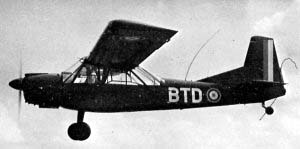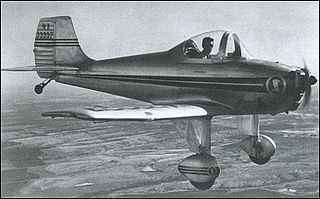
The Globe GC-1 Swift, also known as the Globe/Temco Swift, is a light, two-seat sport monoplane from the post-World War II period.

The Piper PA-15 Vagabond and PA-17 Vagabond are both two-seat, high-wing, conventional gear light aircraft that were designed for personal use and for flight training and built by Piper Aircraft starting in 1948.

The Stinson 108 was a popular general aviation aircraft produced by the Stinson division of the American airplane company Consolidated Vultee, from immediately after World War II to 1950. It was developed from the prewar Model 10A Voyager. Stinson was bought by Piper Aircraft in 1949. All Stinson model 108, 108-1, 108-2, 108-3 and 108-4 aircraft were built by Stinson at Wayne, Michigan. When Stinson sold the type certificate to Piper in 1949, approximately 325 airplanes of the 5,260 model 108s built by Stinson were complete but unsold. These 325 model 108s went to Piper as part of the sale. Piper then sold that inventory as the Piper-Stinson over the next few years.

The Gulfstream American GA-7 Cougar is an American all-metal, 4-seat, twin-engined light aircraft. The Cougar was a twin-engine development of the Gulfstream American AA-5B Tiger and traces its lineage to the AA-1 Yankee Clipper and the Bede BD-1.

The Aeronca Chief is a single-engine, light aircraft with fixed conventional landing gear and two seats in side-by-side configuration, which entered production in the United States in 1945.

The Aeronca 15AC Sedan is a four-seat, fixed conventional gear light airplane which was produced by Aeronca Aircraft between 1948 and 1951. Designed for personal use, the Sedan also found applications in utility roles including bush flying. The Sedan was the last design that Aeronca put into production and was the largest aircraft produced by the company.

The Auster J/4 was a 1940s British single-engined two-seat high-wing touring monoplane built by Auster Aircraft Limited at Rearsby, Leicestershire.

The Bellanca 14-13 Cruisair Senior and its successors were a family of light aircraft that were manufactured in the United States by AviaBellanca Aircraft after World War II. They were a follow-up to the prewar Bellanca 14-7 and its derivatives.

The Goodyear GA-2 Duck was a 1940s American three-seat light amphibious aircraft built by the Goodyear Aircraft Corporation. The design team included David Thurston, who later developed several other light seaplanes including the Colonial Skimmer, Lake Buccaneer, Thurston Teal and Seafire. Only 19 aircraft were built, and these were used only for testing and as demonstrators.

The Harlow PJC-2 was a 1930s American four-seat cabin monoplane, designed by Max Harlow.
The Piper PA-6 Sky Sedan was a 1940s American four-seat light aircraft designed and built in prototype form by Piper Aircraft at its Lock Haven, Pennsylvania, factory.

The Nord 3400 Norbarbe was a French two-seat observation and casualty-evacuation aircraft built by Nord Aviation for the French Army Light Aviation.

The SAI KZ VII Lærke was a light utility aircraft built in Denmark shortly after the Second World War. Based on the SAI KZ III air ambulance, the KZ VII was a strut-braced, high-wing monoplane of conventional design with an enclosed cabin for four seats. Fifty-six aircraft were built, and another 22 partially completed aircraft were destroyed in a factory fire in 1947. The Danish Air Force operated 10 of the type as trainers between 1950 and 1977.

The Luscombe 10 was a single-seat sport aircraft built in the United States in 1945. It was a conventional, low-wing cantilever monoplane with fixed, tailwheel landing gear, designed for aerobatics. The wings, tail unit, and engine section were all adapted from the Luscombe 8, while the fuselage center section was an all-new design, relocating the Model 8's wings from a high to low position.

The SZD-18 Czajka was a single-seat glider designed and built in Poland in 1956.

The Partenavia P.53 Aeroscooter was a 1950s Italian single-seat light aircraft fitted with a two-bladed rotor. It was designed by Luigi Pascale with Mario de Bernardi and built by Partenavia.

The Schleicher Ka-4 Rhönlerche II, sometimes called the KA-4 or even K 4, is a West German high-wing, strut-braced, two-seat glider that was designed by Rudolf Kaiser and produced by Alexander Schleicher GmbH & Co.

The Kawasaki KAT-1 is a Japanese primary trainer, seating two in tandem, designed to compete for a Japanese Air Defense Force (JADF) contract in the mid-1950s. Only two were completed.

The Sud-Est or SNCASE SE-2100, sometimes known as the Satre SE-2100 after its designer, was a tailless, pusher configuration touring monoplane with a single engine and cabin for two. Only one was built.

The Hoppi-Copter was a functional backpack helicopter developed by the American company Hoppi-Copters Inc. founded by Horace T. Pentecost in the 1940s. The original Hoppi-Copter consisted of two contra-rotating rotors on a pole attached to a motorized backpack. Although it was capable of flight, it was extremely hard to control.




















